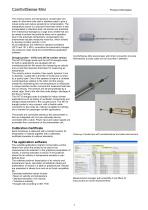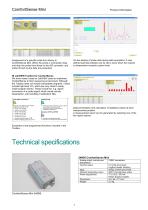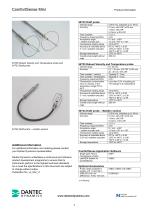
Catalog excerpts

Features • Draught rate according to ISO 7730 • Measures velocities from 0.05 m/s to 30 m/s • High accuracy, fast response and temperature compensated • Stainless steel stem with protection cover for the sensors • Analog voltage output • Optional A/D converter with USB 2.0 interface • Individual calibration certificate traceable to national standards with each transducer Applications • Mapping of air velocity distribution in open and confined spaces • Velocity recordings in wind tunnels • Measurements around diffusers and grilles • Measurements in ventilation ducts • Testing of fans and blowers • Calibration reference for anemometers Introduction The ComfortSense Mini is a compact and robust single point anemometer that covers a wide range of applications. With an easy exchange of probes the ComfortSense Mini covers both high velocity measurements in ventilation ducts as well as draught measurements in offices for example. The velocity probes are based on the well-proven technology of thermal anemometry, which offers the following benefits: wide velocity range, increasing sensitivity as velocity decreases and fast response. This makes it particularly suitable for very low velocities, at which other methods either fail or become too inaccurate. Description High velocity probe - 54T35 The 54T35 Robust high velocity and temperature probe is together with the 54N95 anemometer, a complete temperature compensated thermal anemometer. It covers velocities from 0.1 m/s to 30 m/s in the temperature range from -20°C to 80°C. It is therefore a true alternative to a Pitot-static tube at low to medium velocities, while at very low velocities, say below 2 m/s; it is the only realistic choice. The 5435 high velocity probe is delivered with traceable calibration certificate. DANTECDYNAMICS Nnova instrument;
Open the catalog to page 1
ComfortSense Mini Product Information ________________________________________________________________________________________________ The velocity sensor and temperature compensator are made of nickel wire coils clad in stainless steel to give a robust probe and reduce sensitivity to contamination. The temperature sensor is a precision thermistor which is also encapsulated in stainless steel. All sensors are protected from mechanical damage by a cage and a shield that can be raised to protect the probe tip when not in operation. Due to the automatic temperature compensation the anemometer...
Open the catalog to page 2
Product Information ComfortSense Mini Assignment of a specific probe from library to ComfortSense Mini. When the probe is connected, drag and drop the probe from library to the A/D converter, and probe ID and on-line data are presented. On-line display of probe data during data acquisition. A user defined warning indicator can be set to show when the velocity or temperature exceeds a given level. NI LabVIEW Toolbox for ComfortSense We have made it easy for LabVIEW users to implement ComfortSense to their measuring environment. Although the Toolbox does not contain executable programs, it...
Open the catalog to page 3
Product Information Velocity range 54T35 Robust Velocity and Temperature probe and 54T33 Draft probe. 54T35 Robust Velocity and Temperature probe Additional information For additional information and ordering please contact your Dantec Dynamics representative. Dantec Dynamics undertakes a continuous and intensive product development programme to ensure that its instruments perform to the highest technical standards. As a result the specifications in this document are subject to change without notice. Publication No.: pi_242_v1 ComfortSense Application Software Optional Accessories Velocity...
Open the catalog to page 4All Dantec Dynamics A/S catalogs and technical brochures
-
F-Q-480
2 Pages
-
F-Q-400TCT
2 Pages
-
Q-400 μDICTM
2 Pages
-
5 Beam 112mm probe
2 Pages
-
LabVIEW Toolbox for CTA
2 Pages
-
Least Squares Matching (LSM)
3 Pages
-
DynamicStudio Base Package
5 Pages
-
Flow Field
8 Pages
-
HiSense 600 series
2 Pages
-
FlowSense EO
4 Pages
-
HiSense Zyla
2 Pages
-
DISATAC Tachometers
56 Pages
-
Laser Doppler Anemometry
8 Pages
-
Probes for hot-wire anemometry
25 Pages
-
FlowExplorer compact LDA
2 Pages
-
DynamicStudio
8 Pages
-
Spray Diagnostics Solutions
8 Pages
-
Wind Turbine Optimization
8 Pages
-
Laser shearography (Q-800)
2 Pages
-
Q-501 Real Time Mode Monitor
2 Pages
-
PDA systems
8 Pages








































